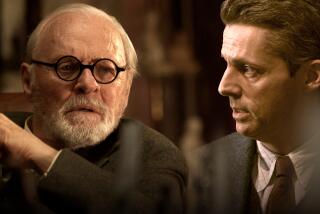From the Archives: â84 Charing Cross Roadâ defies distance to dispense literate love
â84 Charing Cross Roadâ is a joyous celebration of the life of the imagination which here dramatizes how books enrich our lives and build bridges between people. Whatâs more, the film affords both Anne Bancroft and Anthony Hopkins some of the warmest and most winning moments of their screen careers.
Bancroft plays New York writer Helene Hanff who, despairing of finding in Manhattan bookstores certain works she cherishes, writes to Marks and Co., 84 Charing Cross Road, London. She has no way of knowing that, on Oct. 5, 1949, she has just embarked upon one of the most important and sustaining relationships of her life.
Frank Doel (Hopkins), the man who answers Hanffâs note at Marks and Co., soon realizes that he has met through transatlantic mail a fellow book lover. Hanff is bowled over by Doelâs British courtesy, but it takes her a while to dent his reserve. What really breaks the ice is Hanffâs thoughtfulness in sending him a steady supply of foods and goods, in such desperately short supply in postwar Britain. In return for her kindness, Hanff finds herself corresponding not only with Doel but with his co-workers and eventually with his wife, Nora (Judi Dench), and their small daughters. Through letters, Hanff has discovered a whole new world, and in her, her new English friends have found a kind of fairy godmother.
Hanffâs collection of her and her friendsâ correspondence became the basis of a play and also a British television drama, which was adapted by Hugh Whitemore (âStevieâ), who then wrote the script for this film. Whitemore has been completely faithful to the letters while bringing to life the deftly intercut worlds of Hanff and Doel. In providing so beautifully designed a blueprint, he has freed director David Jones (âBetrayalâ) to get the very best possible from his actors. For all its quotations from the correspondence and all its literary references, â84 Charing Cross Roadâ is a real movie with a fully rounded life of its own.
What a pleasure it is to watch Anne Bancroft in a role that fits her like a glove. Her Hanff is as earthy and blunt as Hopkinsâ Doel â the epitome of civility without stuffiness â is calm and polite. But they are equal in their intelligence and sensitivity and in their capacity for appreciating all thatâs good and worthy in life and people, as well as in history and literature. (Interestingly, neither went to college.) The love that develops between them is the kind that accommodates its particular epistolary circumstances and might not have flourished and survived were the conditions otherwise. Indeed, â84 Charing Cross Roadâ generates considerable suspense as to whether Hanff and Doel, both living on limited incomes, are ever going to be able to meet face to face.
The production design of â84 Charing Cross Roadâ is not the kind that calls attention to itself, but it is absolutely crucial to the filmâs success. Designer Edward Pisoni in New York and his London counterpart Eileen Diss have met the challenge triumphantly in re-creating a 20-year time span when both cities were undergoing tremendous changes. The harmony of Hanff and Doelâs friendship is reflected in the complementary work not only of Diss and Pisoni but of costume designers Jane Greenwood (New York) and Lindy Hemming (London).
Hanff, who apparently lost the love of her life in World War II â we notice an affectionately inscribed framed photo of a smiling naval officer â was probably more in need of the correspondence than Doel, a happy family man. Yet even Denchâs lovely and loyal Nora acknowledges envying Hanff her writing ability that so delighted her husband and the sense of humor he shared with Hanff.
